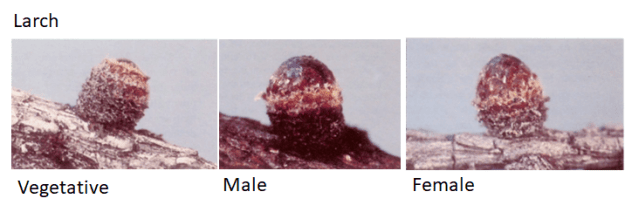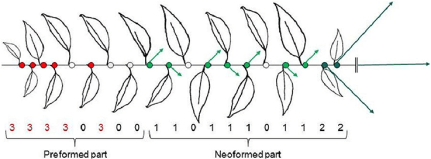You’ve probably heard of rooting hormone powder, or auxin, or gibberellins – these are all ‘Plant Growth Regulators’. Plant Growth Regulators used to be known as ‘phytohormones’ which means plant hormones. This has been quite a contentious topic among plant biologists.
A hormone in an animal is a chemical messenger, a substance which acts as a signalling or control molecule to cause an action to take place. “Hormones carry out their functions by evoking responses from specific organs or tissues that are adapted to react to minute quantities of them”ref. In animals, hormones are produced at a specific site (a gland, like the pancreas), work at low concentrations, and have a predictable dose-response. That is, an increase in hormone will result in the more of the related action (eg. more insulin leads to more sugar being taken up by the liver).
There *are* substances synthesised by plants which are involved in regulating growth – plant growth regulators – but they don’t work in the same way as animal hormones. It’s said that the assumption that they did sidetracked plant researchers for decades.ref Plant ‘hormones’ are synthesised in multiple sites in a plant (and potentially in every cellref), have multiple actions on different cells (they don’t act on just one organ or tissue), don’t exhibit predictable dose-response behaviour like animal hormones and are involved in significant interactions or feedback loops with each other.ref
What this means is that it’s quite hard to unpick what they do and how they work. The roles and mechanisms of plant growth regulators are still very much current research topics, as can be seen at two of the research groups at Cambridge University’s Sainsbury labref1,ref2 Some of the early theories about them were comprehensively demolished in a seminal article by Anthony Trewavasref (in particular the theory of auxin-derived apical dominance which was later proven wrong as explained below).
We now know that plant growth regulators act in concert with genes and the proteins they express, and not as an independently acting substance (one of the genes involved in cytokinin synthesis is known as LONELY GUY…).
So what are the plant growth regulators, where and how are they made? There are nine main plant growth regulators you may come across in your reading:
- Auxinref – classically called ‘the growth hormone’ and a signal for division, expansion, and differentiation throughout the plant life cycle – involved in root formation, branching, the tropic responses, fruit development, shoot meristem function, the development of cotyledons and senescence. The most common form is Indole-3-acetic acid (IAA). Auxin acts in a ‘ying-yang’ relationship with cytokinin (see below)ref as well as with gibberellins. More about auxin below.
- Cytokinins (CK)ref1 ref2 – involved in cell division, shoot initiation and growth (including maintaining the stem cell niche), nutritional signaling, root proliferation, phyllotaxis, vascular bundles, leaf senescence, branching and nodulation, seed germination, nutrient uptake, and biotic and abiotic stress responses. 6-BAP or 6-Benzylaminopurine is a synthetic cytokinin which is used in micropropagation and agriculture. Coconut water (not milk) has been found to be a natural source of cytokinins.ref
- Brassinosteroidsref – involved in a wide spectrum of physiological effects, including promotion of cell elongation and division, enhancement of tracheary element differentiation, retardation of abscission, enhancement of gravitropic-induced bending, promotion of ethylene biosynthesis, and enhancement of stress resistance.
- Gibberellins (GA)ref – involved in multiple processes including seed germination, stem elongation, leaf expansion and flower and fruit development.
- Strigolactones (SL)ref – induce hyphal branching of arbuscular mycorrhizal fungi and are shoot branching inhibitors.
- Abscisic Acid (ABA)ref – involved in the induction and maintenance of seed dormancy, stomatal closure, and response to biotic and abiotic stresses.
- Jasmonates (JA)ref – shown to be inhibitors of growth but also involved in development of flowers and defense responses against herbivores and fungal pathogens
- Salicylic Acid (SA)ref – associated with disease resistance
- Ethyleneref – multiple effects on plant development including leaf and flower senescence, fruit ripening, leaf abscission, and root hair growth.
Slightly maddeningly none of these substances do just one thing – they’re all involved throughout the plant!
So how and where they are made in a plant? This isn’t simple either. In fact local biosynthesis is thought to be critical for plants, whereby plant growth regulators are made at the site where they are needed. For example both auxin and cytokinin are synthesised in leaves *and* in rootsref, and can be made by chloroplasts and mitochondria, organelles which occur throughout the plant.ref Chloroplasts can make precursors to auxin, abscisic acid, jasmonates and salicylic acid.ref
Even though plant growth regulators don’t act in a predictable dose-response way like animal hormones, they still have a role in shaping plant growth in tissues which are sensitised to respond to them. Theoretically by understanding these responses we can manipulate a tree’s growth. And this is what they do in plant tissue culture (more on that below).
You may have heard the theory of auxin-controlled ‘apical dominance’, which holds that auxin produced by leaves at the apex inhibits lateral buds. This theory was strongly criticised by Trewavas in 1981: “The only hypothesis of apical dominance which has retained some measure of support is the nutritional one. A number of plants placed under conditions of reduced nutritional status adopt a growth pattern of strict apical dominance.” His point of view was further supported by a 2014 study which found that “sugar demand, not auxin, is the initial regulator of apical dominance”.ref The researchers found that after removal of the shoot tip, sugars were rapidly redistributed over large distances and accumulated in axillary buds within a timeframe that correlated with those buds releasing. But auxin didn’t travel fast enough to be responsible for bud release. So basically they found that apical dominance arises because the main shoot is greedy for sugars, and due to its position at the end of the vascular system it can prevent lateral buds from taking the sugars needed to release and grow.
Auxin does play some role though, and the theory is that its role related to the fact that it’s the only plant growth regulator which displays polar transport. That is – it moves from the apex to the base of the plant, via the phloem, and can travel the entire length of the plant, ending up in the roots. This gives auxin a special role related to the spatial aspects of growth, and auxin ‘maxima’ (locations where auxin accumulates) are sites where new buds, flowers or lateral roots emerge. In fact, auxin and cytokinin work in concert throughout the plant, from shoots to roots, with apparently opposite effects in each location “like yin and yang”.ref
An excellent reference point for this subject is the world of plant tissue culturing. This is where small pieces of plant tissue are sterilised and cultured in a medium containing plant growth regulators, which cause the tissue to grow into a ‘plantlet’ (sometimes in a test tube, if the source material is small). Further steps multiply the plantlet into several plantlets, which are then encouraged to create roots, multiplied again and/or planted out as seedlings to harden off. This process is used for industrial plant cloning where large numbers are required, and in the aquarium trade to avoid contamination with snails and other microbes (see Tropica’s website).
In plant tissue culturing, plant growth regulators are used to induce the relevant growth stage, which ones work for each species in which stage is documented in the ‘protocol’ for that species. In all cases specific ratios of cytokinin:auxin (and sometimes gibberellins) lead to different developmental stages – shoot growth, lateral shoot growth and root growth.ref1, ref2 To give you a bonsai-oriented example, one study determined a protocol for the micropropagation of Prunus Mumeref. They were able to multiply fresh prunus mume shoots in a petri dish using a 4:1 ratio of cytokinins to auxins, and then root them using auxin.
So – apologies for the rather long read, it is quite a complicated subject! What can we take from all this for our bonsai practice? Firstly we can stop the brain-bending trying to understand how auxin controls apical dominance because it doesn’t – access to sugars does this instead.
Also we can use the yin-yang rule – high cytokinin:auxin encourages buds & shoots, and high auxin:cytokinin encourages roots. So I’m going to start adding some auxin rooting gel into my air layers and cuttings. Cuttings have never worked for me in the past so maybe this will be the secret sauce I need. I’m also going to try some cytokinin gel to encourage lateral budding on my trees.
If you are looking for products to give this a try, make sure the product actually contains the plant growth regulator you want. For example, Clonex contain auxin, and some of the orchid budding pastes such as Keiki paste contain Kinetin (a cytokinin). Many other ‘rooting hormones’ or plant hormones products on the market have no ingredient list at all, so avoid those. You can also find these products online in shops dedicated to hydroponics, where cloning and plant tissue culturing is a technique used by practitioners, or in lab supply shops such as microscience or Phillip Harris in the UK. You can even make your own hormone gels following these instructions.
Another trick you can use is that gibberellic acid can be used to break dormancy in seeds, if you really don’t have the patience to wait for natural dormancy to break. Or give coconut water a try, this has been found to have a similar effect in a range of species. For hard coated seeds in particular, usually it’s best to search Google Scholar for a researcher who has experimented with different approaches, since what works is very species-dependent.









































